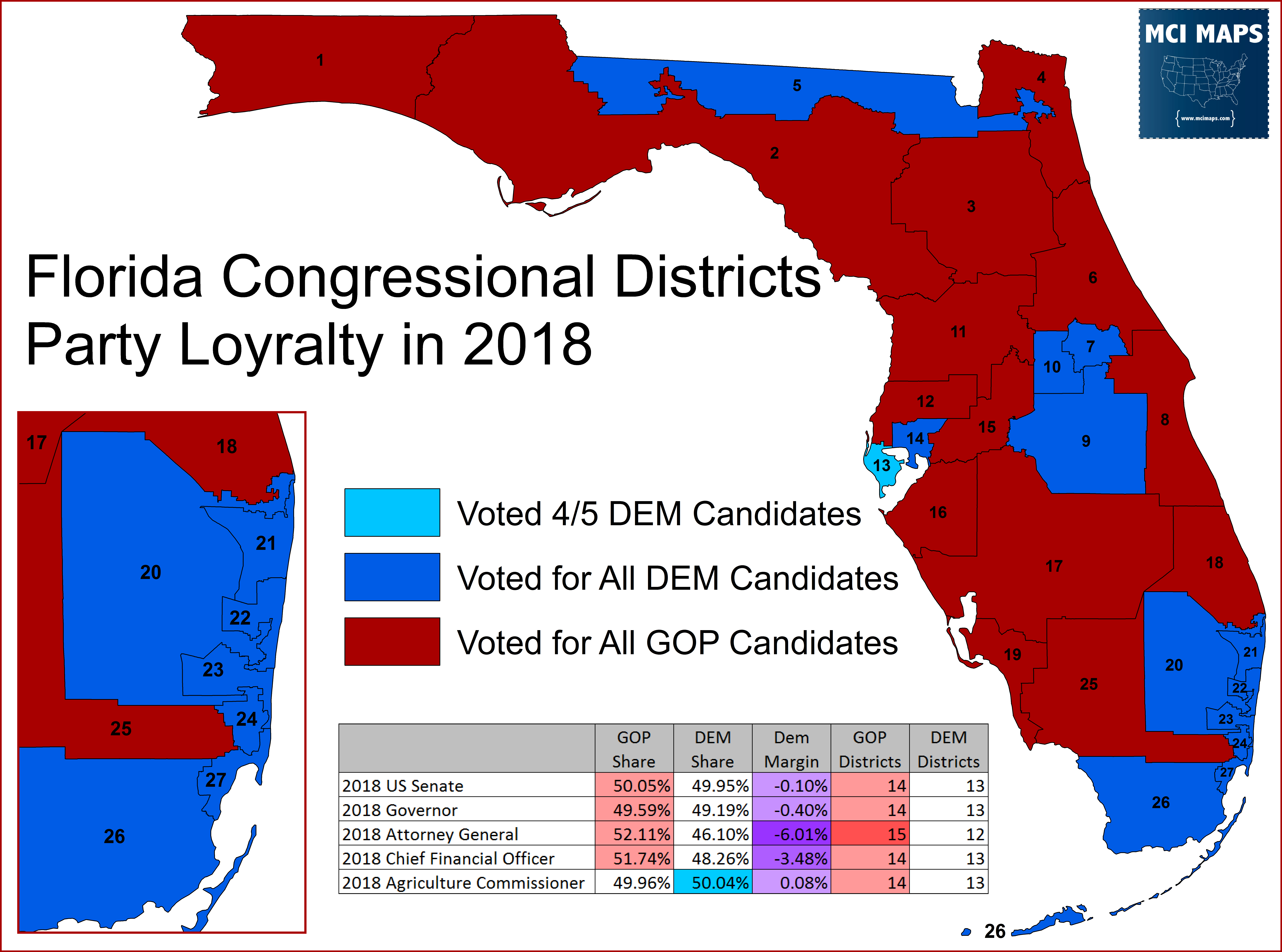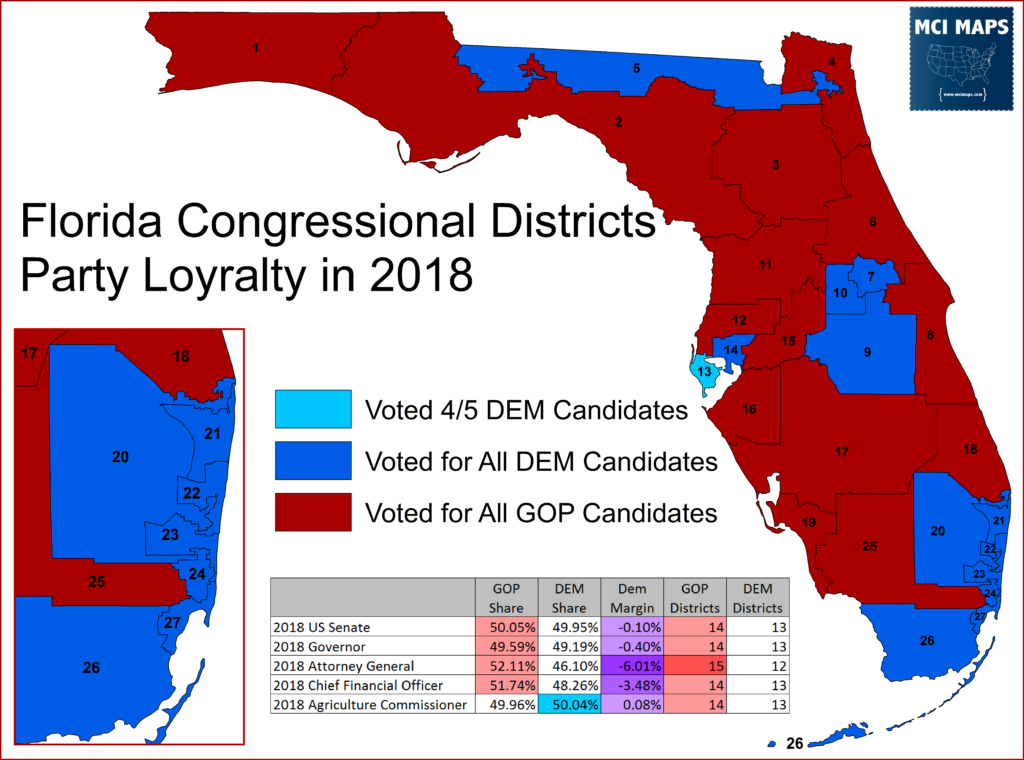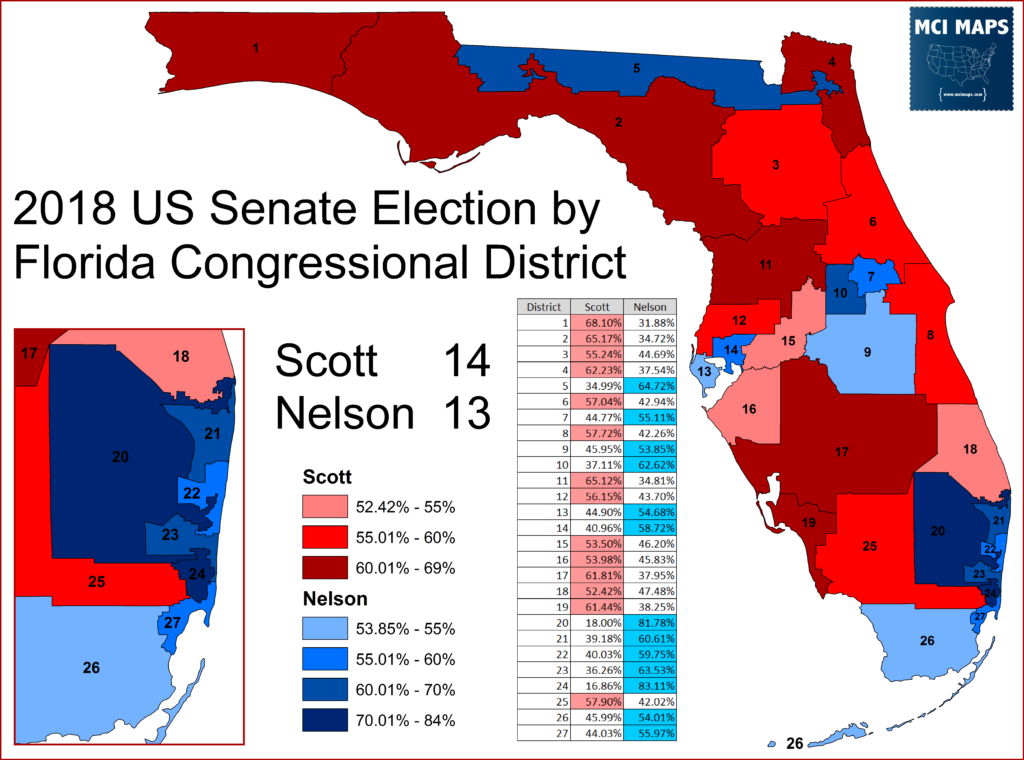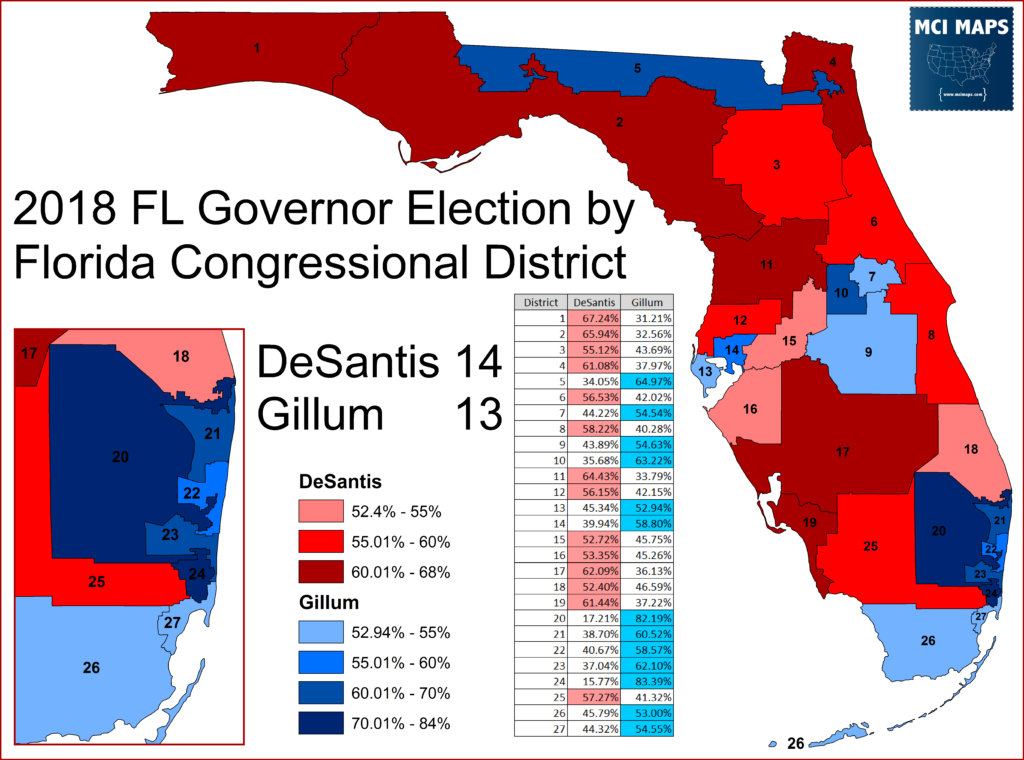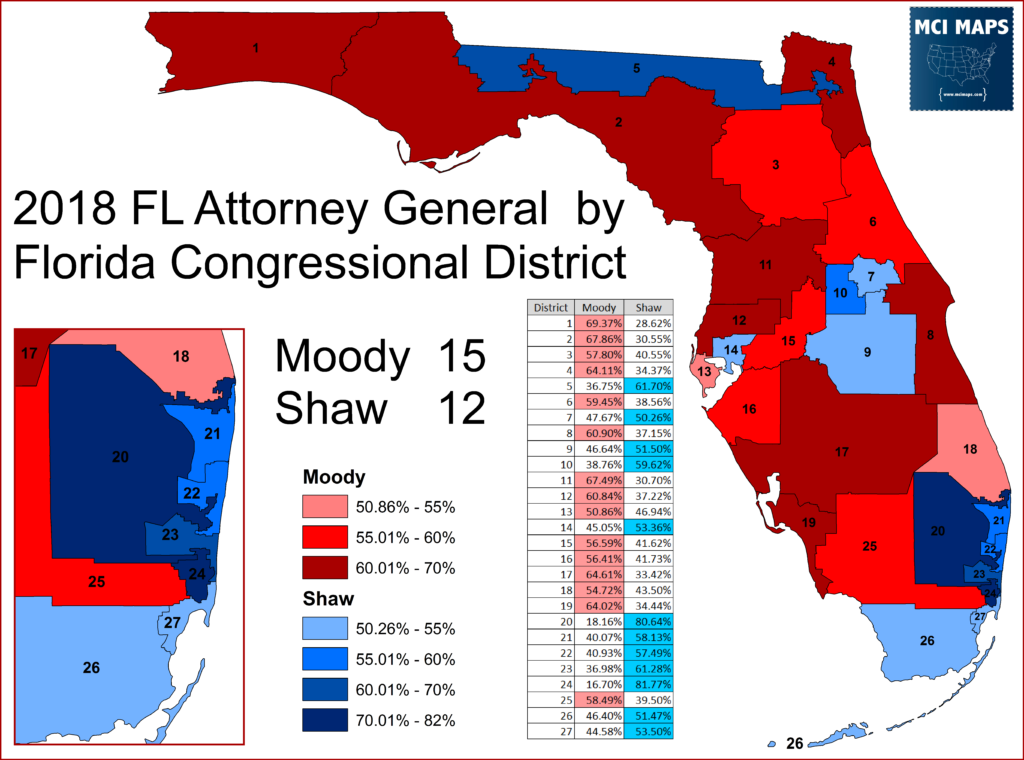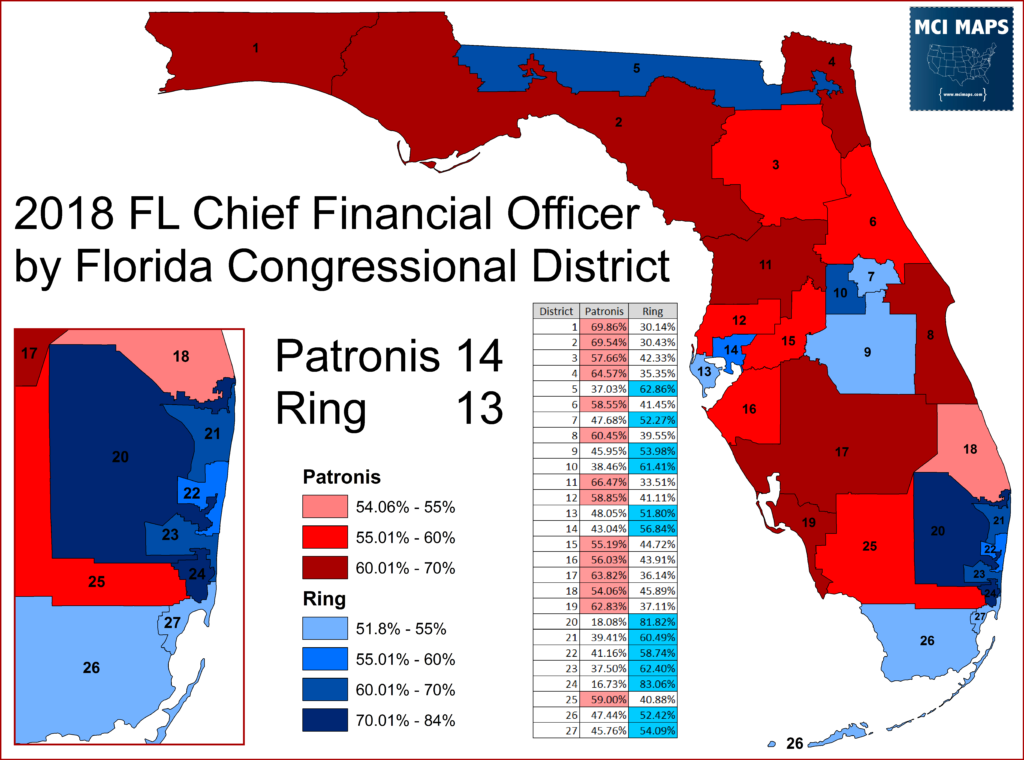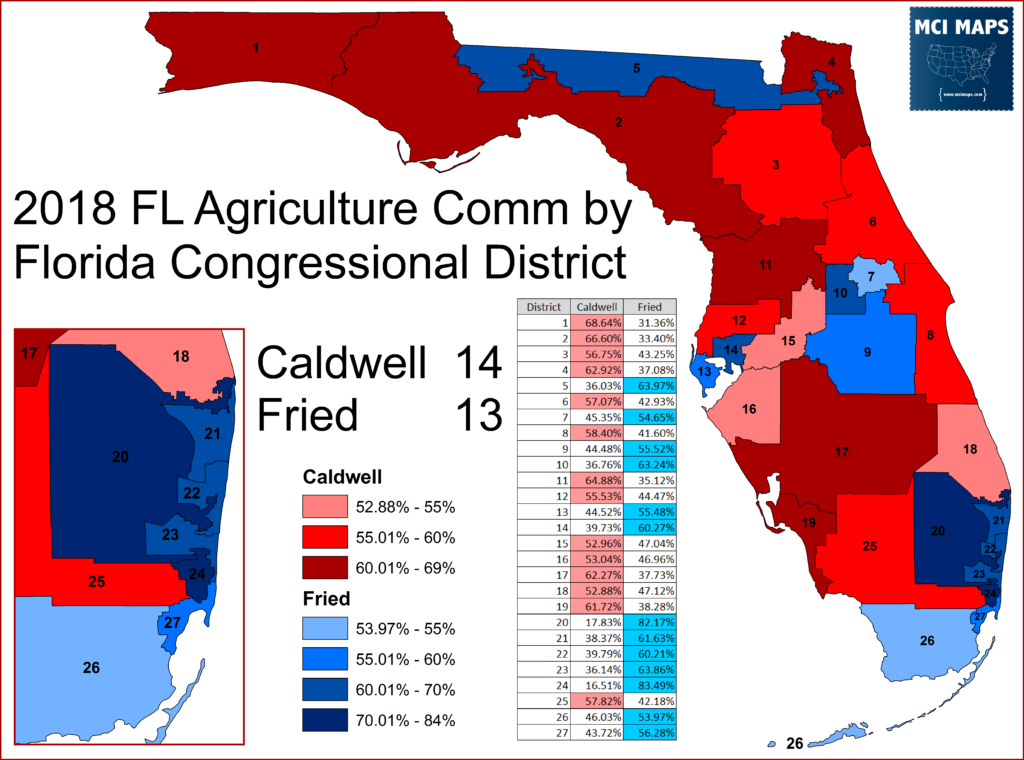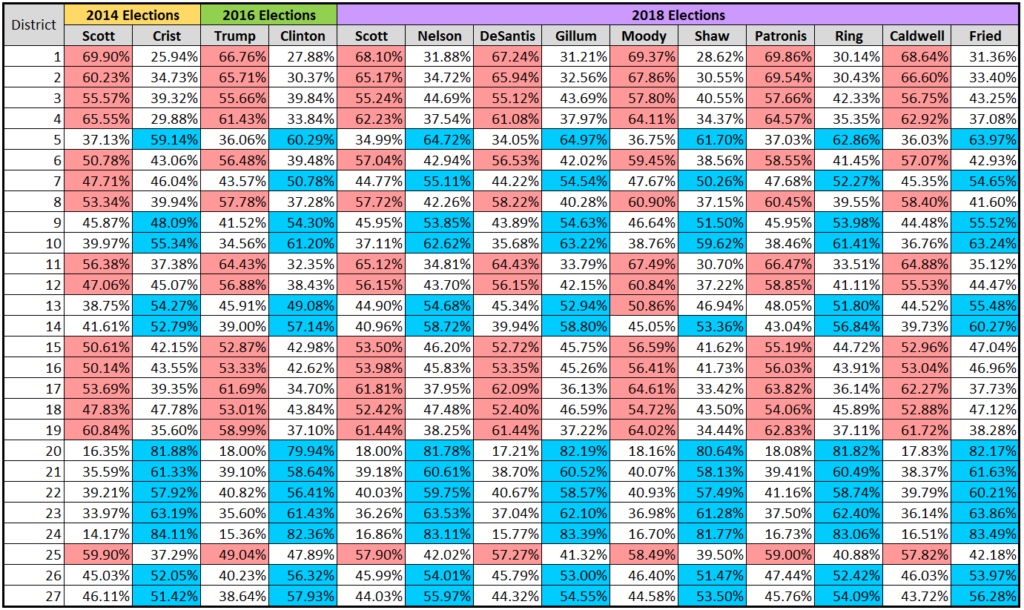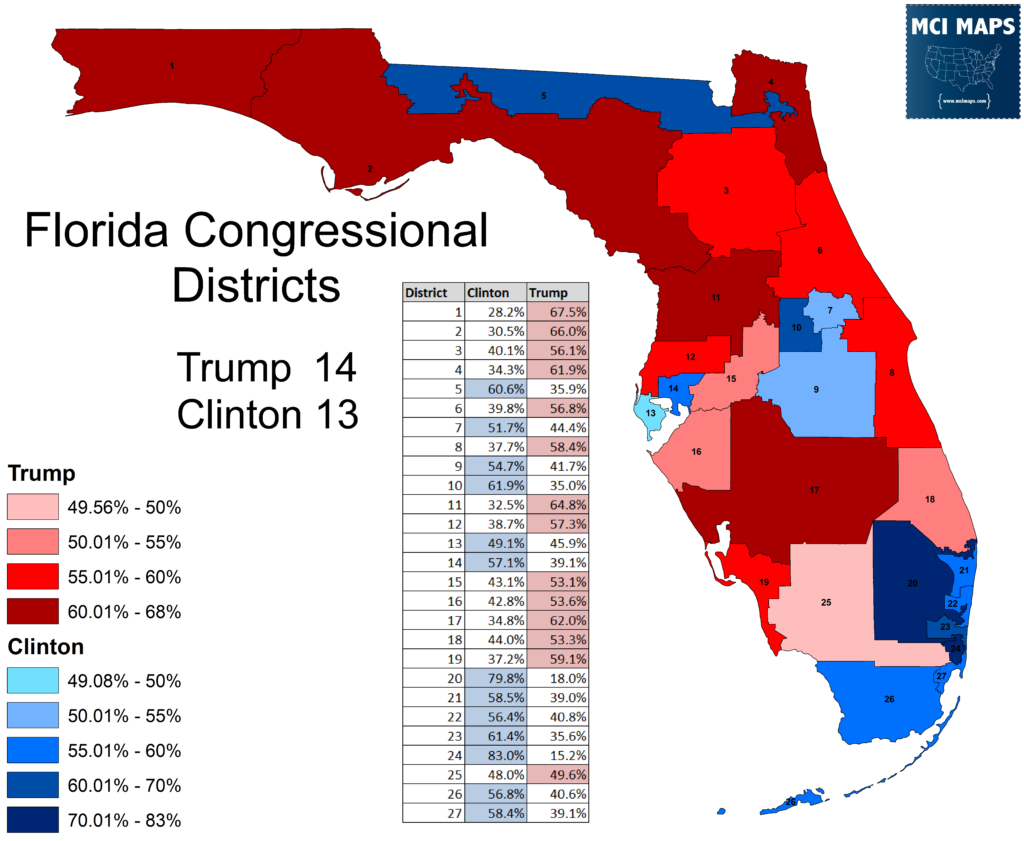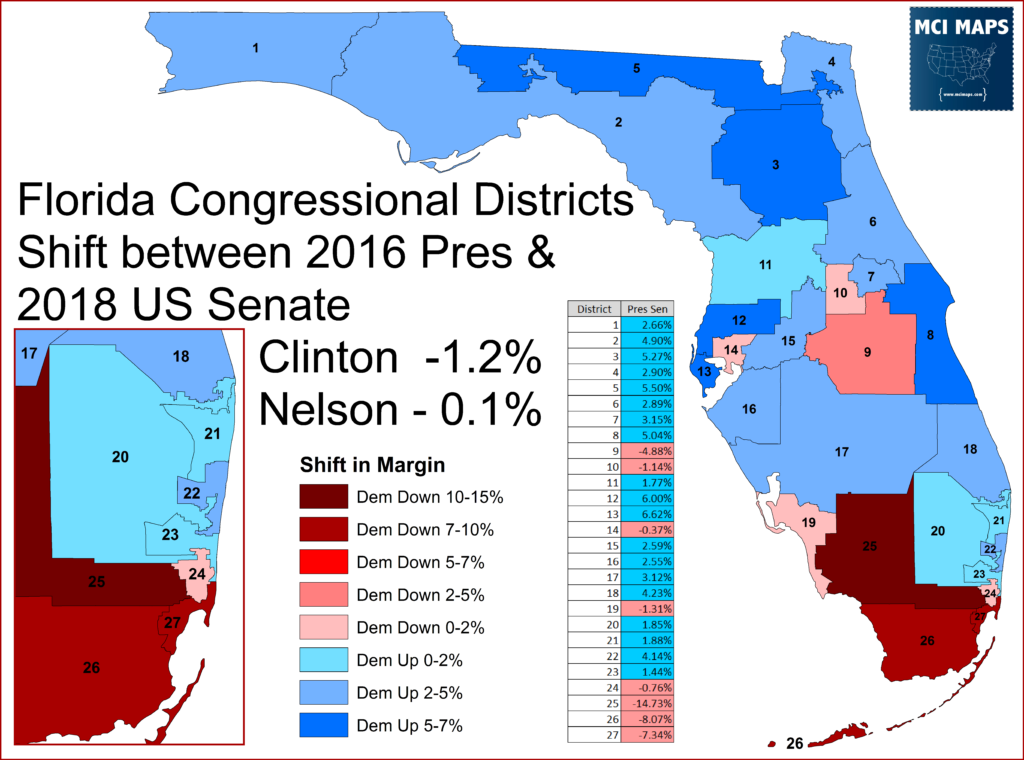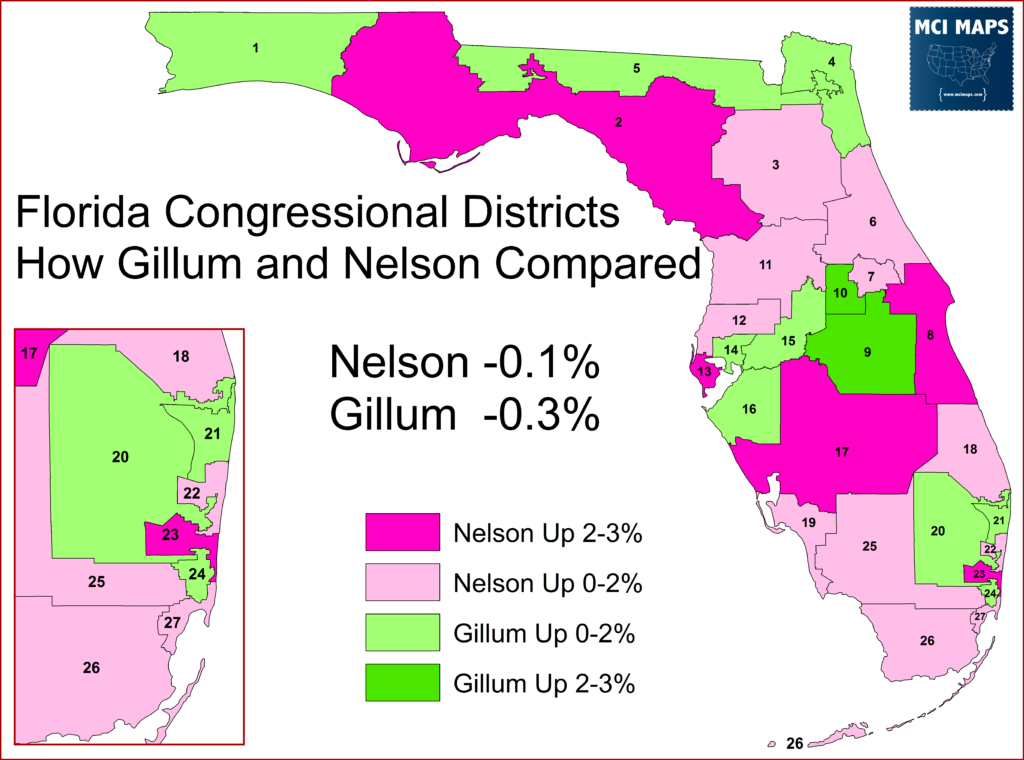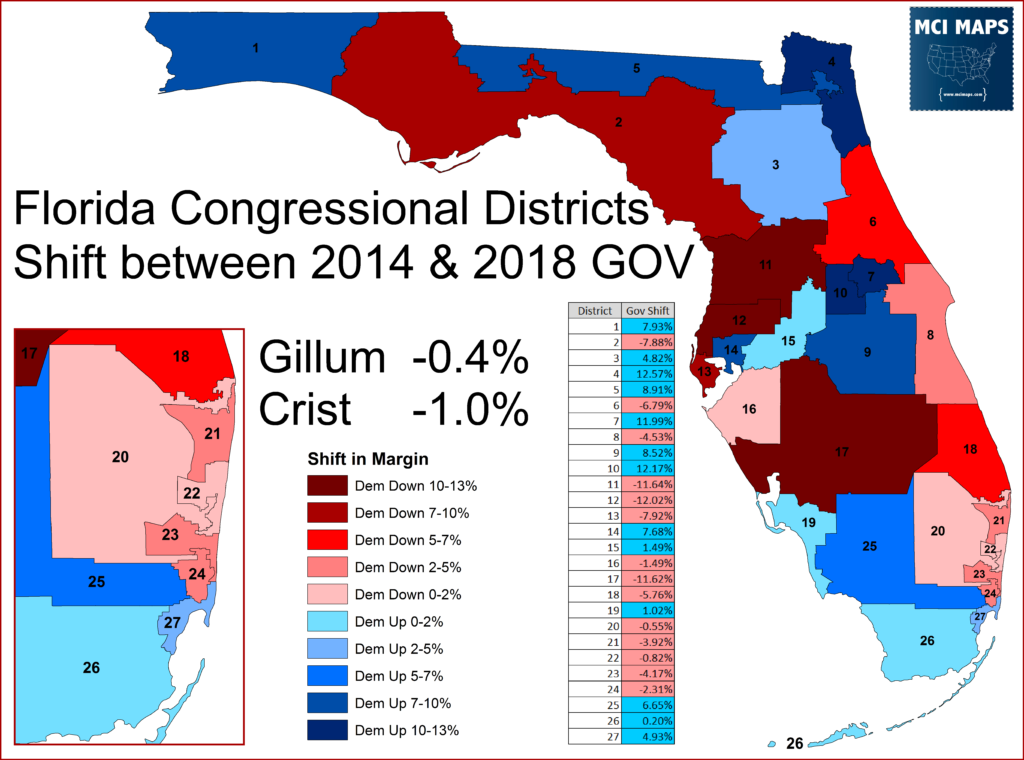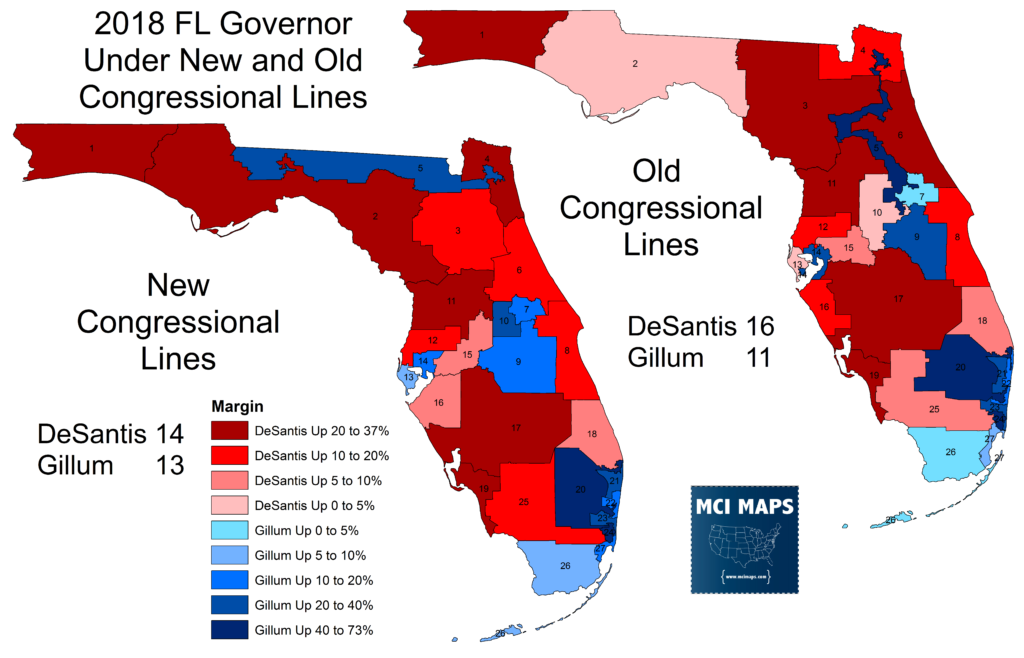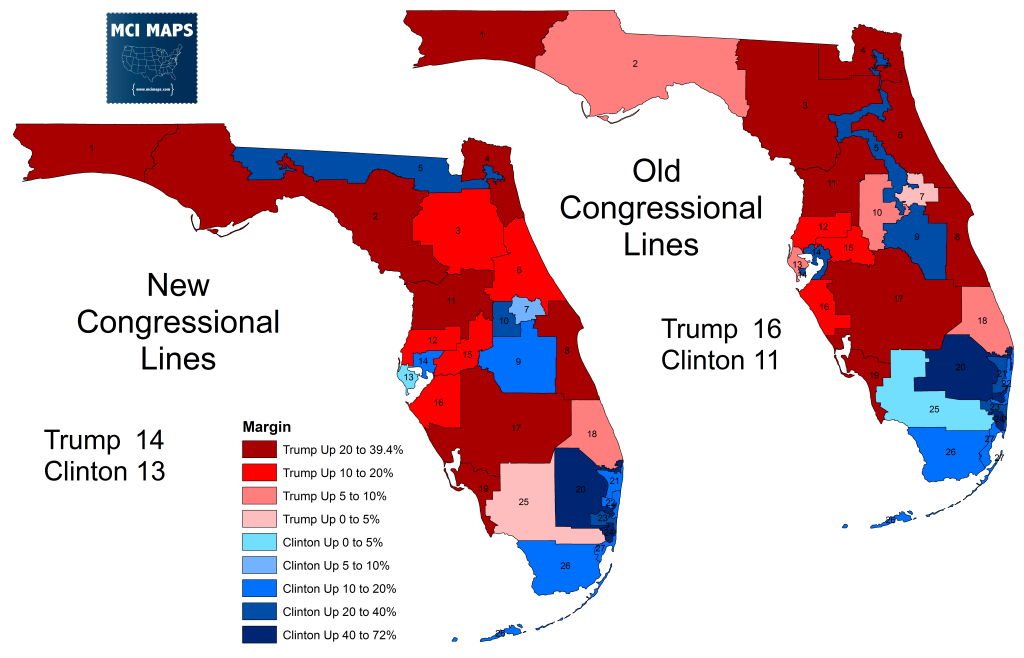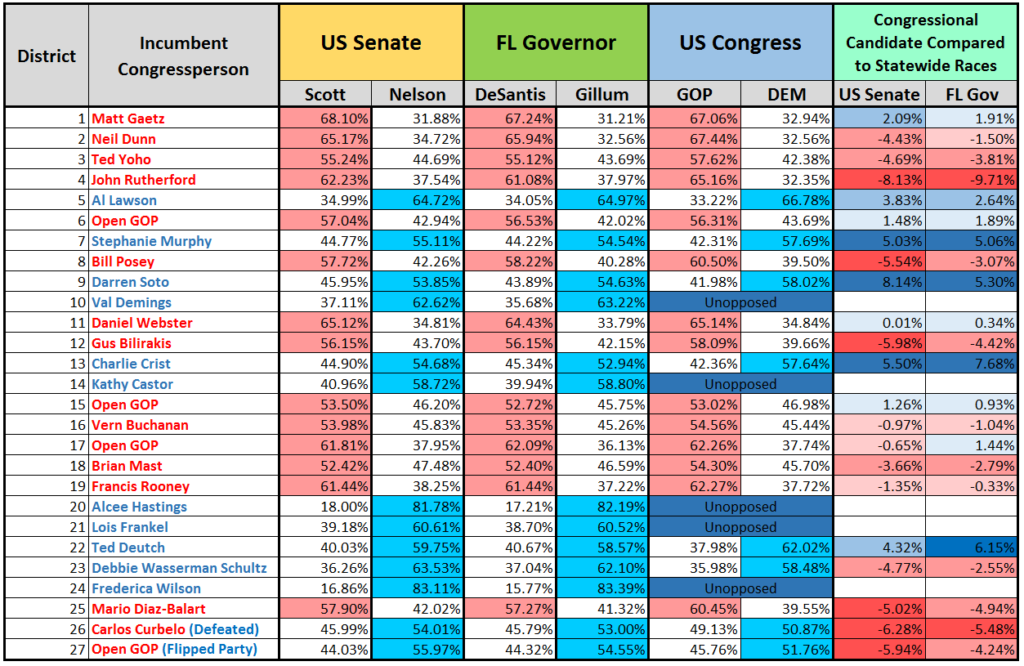Florida has five statewide races on its ballot in 2018. In addition to the high profile US Senate and Gubernatorial contests – Florida held elections for its Attorney General, Chief Financial Officer, and Agriculture Commissioner. All of these races were relatively close. The biggest gap was the GOP’s 6% win for Attorney General. CFO was decided by 3% and the remaining were all decided by less than 1%. This marked one of the closest election seasons in Florida history.
I broke those races down by Congressional district to see how the map, passed after 2015’s mid-decade redistricting lawsuit, reflected the state’s close divide. The results were promising. The lines showed they well-represented Florida’s close political divide. All five Democrats won 12 out of 27 districts, with team blue taking 13/27 in all but the Attorney General Race.
The Attorney General election was the lone race decided by more than 5% – with Judge and former prosecutor Ashley Moody beating Democrat State Rep Sean Shaw by 6%. She managed to get a narrow in the 13th district – which otherwise backed Democrats. Moody heavily over-performed Democrats in the Tampa Bay region (where both she and Shaw hail from).
The other four Democrats all held 13 of the 27 districts easily; with none really in threat of going to the GOP.
The results are also seen in the chart below. Overall the Democratic districts were solid and at little risk of flipping. Conversely the GOP had solid and modest leads in their districts. While this does mean the map has limited elasticity – its also a reflection of Florida’s growing geographic divide and lack of swing regions.
The map looks similar to the 2016 Presidential election breakdown. Hillary Clinton took the same 13 districts in 2016 when she lost the state by just over 1%. A key difference here is her CD13 margin was much tighter but she got much closer in CD25.
Comparing the 2016 Presidential vote to the 2018 elections reveals some notable shifts in vote. The map below compares Nelson’s margin to Clinton’s margin by district. Overall, Nelson did better than Clinton in a majority of the districts, but fell below her in a few key regions.
Nelson’s lost a huge amount of ground in Miami-Dade’s Cuban-heavy districts. This reflects what has already been noted by Florida politicos: the Cuban community didn’t like Trump in 2016 but still leans GOP overall. Cubans have shown a strong willingness to split their tickets – similar to conservative democrats in West Virginia or Kentucky. Especially in a midterm, where older Cubans (who are much more GOP) show up at a higher rate than their younger counterparts, seeing a swing back to the GOP in Cuban-heavy portions of Miami-Dade is not unprecedented. The swing-back was strongest in CD25 – a district based heavily out of Hialeah – an epicenter of Cuban culture.
Nelson also did worse in Puerto Rican-heavy CD9, a reflection of the Scott campaign’s heavy targeting of Hispanics in central Florida. Issues with youth Hispanic turnout also apply here. Both CD10, 14, and 20 also have notable Hispanic populations – but overall are more African-American. CD19 is where Rick Scott is from.
Looking at how the candidates did compared to each-other offers some interesting notes. Comparing Gillum and Nelson’s margins by district, we see Nelson outperforming Gillum in the rural areas of Florida and Hispanic regions of Miami-Dade.
Some of his strongest margins are in the 2nd, an ancestral Democratic area, his home of Brevard, the working-class-based 13th, and suburban Broward. However, all these improvements or drops are very small = maxing out at 3%. Nelson’s fairly weak margins over Gillum in North Florida are really telling about the loss of his appeal in the area. Gillum, meanwhile, did better than Nelson in the districts African-American districts (5, 10, 20, 24) but also in whiter districts like the 4th and 1st. Gillum also did slightly better with Hispanics in the Orlando market, partly thanks to Scott’s aggressive campaign there vs DeSantis’ weak one, allowing him to over-perform in the Hispanic-influenced 9th.
Examining Nelson’s performance compared to his 2012 re-election shows a drastic drop across most constituencies. Nelson went from winning by 13% to losing by just 0.1%, and as a result he did worse in every district. Nelson’s margin fell by the most in CD11, a district home to working class voters along the coast and the growing Villages retirement community inland.
Meanwhile, some of the smallest shifts for Nelson were in South Florida. Nelson only modestly lost ground in much of Broward and in the 27th district (which has a smaller Cuban population than the 26th or 25th). Nelson’s biggest drops came from areas where he long over-performed Democrats. This election, he essentially became “just another democrat” with only minimal ticket splitting appeal.
Looking at how Gillum did compared to the last Democrat to run for Governor, Charlie Crist, shows how much the state is changing internally despite minimal movement statewide. Gillum out-performed Crist in many districts, but also lost ground in several others.
Gillum did notably better in districts with large African-American populations (14th, 5th, 10th) but actually under-performed Crist in the Broward and Dade based 20th and 24th, which are both African-American. Crist has extremely high margins in the Broward, Palm and Dade County region in 2014 – having invested much of the campaign’s operation there – making it a hard margin for Gillum to overcome. Gillum did over perform Crist with the Cuban districts in Miami-Dade. The 25th had notably gone from being only narrowly for Trump to overwhelmingly for Scott and DeSantis. However, Gillum and Nelson both did better than Crist had done in 2014. This again highlights the issue of using the 2016 Presidential election in Miami-Dade; where Trump’s disapproval with Cubans boosted Clinton but few other democrats. Older Cubans, who have stronger say in midterms, are still ancestrally Republican at heart. That said, Gillum’s improvement over Crist shows that even in midterms that Cubans trending blue – but slowly.
Gillum did much worse than Crist in working-class and rural districts – with notably examples being the Lean-GOP 18th and lean-DEM 13th. However, Gillum has recorded record improvements in the suburban-based 4th, 10th and 7th. The 10th also has a large African-American population, but like the 4th and 7th, it saw white suburbs move more to the Democrats.
Effects of Redistricting
Florida went through an intense mid-decade redistricting in 2015 when the state was sued over its maps. Several districts were struck down and a full redraw took place. After internal legislative fights and intense hearings, the state court decided on a final map that incorporated districts from the legislature and from the group that sued over the lines to begin with. Early analysis showed the final products where more representative of the state and this has been confirmed by the 2016 and 2018 elections. I did want to look back though and see how the statewide races would have broken down using the older lines. The results of that can be seen below.
Under the old lines. Gillum would only win 11 districts to DeSantis’ 16 – with the 10th and 13th both voting for the GOP. Racially gerrymandering is the cause here. The old lines had district 14, based in Tampa, cross the Tampa Bay to take in African-Americans in southern Pinellas. Meanwhile, the old 5th stretched from Jacksonville to Orlando and took in African-Americans from the Orlando region, keeping them out of the 10th. In addition to these flips, the 7th is much less democratic thanks to Seminole county’s small black population being given to the 5th and the district and it losing Hispanics to the 9th (which makes the 9th more democratic than under current lines).
Democrats will still be in the running for the 2nd district under these lines – which used to be a lean-R but swingish district where old democratic dominance was moving more toward the GOP. In 2014, the old 2nd was one just two district nationwide to oust a GOP incumbent when Gwen Graham beat Congressman Steve Southerland. The district would have backed DeSantis by 5 and Scott by 3 (an improvement from the estimated 9 point win Trump would have taken it by in 2016). They also fair better in the old 25th, which used to include parts of southwestern Broward County – a heavily democratic pocket.
Breakdowns for the governor and senator races under the old lines are below. Nelson would actually do one district better than Gillum under these lines – narrowly taking the 13th.
The 2016 Presidential results are below as well. They show the same dynamic that 2018 did – less districts won despite just a narrow loss. One difference is Clinton won the old 25th but didn’t win the old 7th.
The comparisons to the old lines show the power of redistricting.
Congressional Delegation
Despite the statewide losses, Democrats in Florida actually picked up two congressional seats. Both based out of Miami-Dade.
Democrats were long-expected to pick up the 27th district – left open by longtime popular Republican Ileana Ros-Lehtinen. That should have been a lock considering how Democratic it was becoming and its smaller Cuban population. However, it became a much more heated fight as Democratic nominee Donna Shalala, who didn’t speak Spanish, had a tough fight against Republican nominee Maria Elvira Salazar, a longtime journalist and broadcaster in the region. Dueling internals pointed to different leaders but the consensus was that the race was close but Shalala would benefit from the blue environment. Indeed in the end Shalala won by 6 points, a decent win but smaller than Gillum or Nelson in the district.
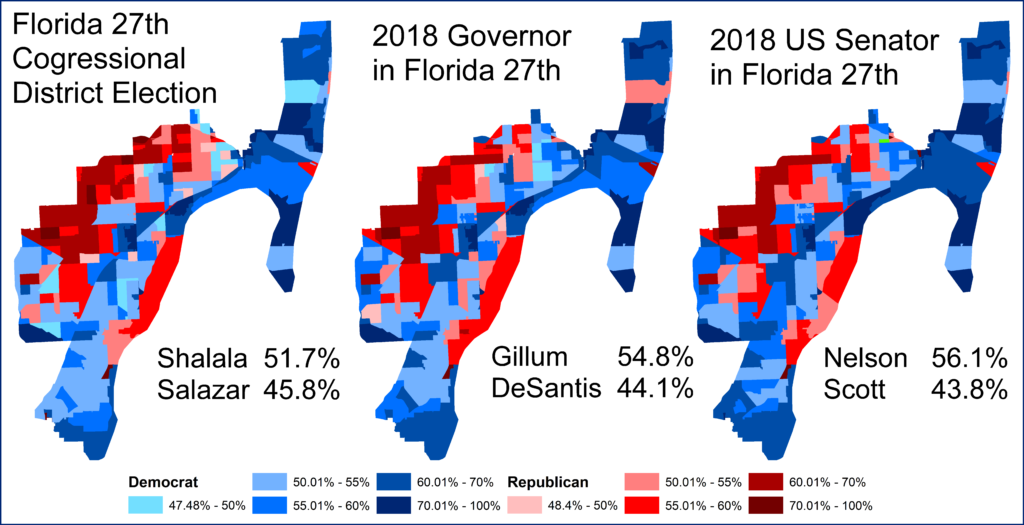
By far the more impressive win took place in the 26th. Republican Incumbent Carlos Curbelo was considered tough to beat despite his districts’ blue lean. Democrat Debbie Mucarsel-Powell, who had run for state senate in 2016, was recruited to take on the Congressman. Most democrats had flocked to the 27th open seat, leaving fewer challengers willing to take on Curbelo, who’s moderate image (not so much moderate voting record) and large financial backing made him a tough beat. Ratings fluctuated from tossup to Lean R through the cycle and it seemed like Curbelo might be one of the Republicans in Clinton-backing districts who could hold on. However, he wound up losing to Powell by 2%.

Curbelo did over-perform Scott and DeSantis, who took around 46% of the vote, but it was not enough to save him. Debbie Mucarsel-Powell now gets the reputation as someone who beat a strong incumbent in an upset.
Other Congressional Races
I hold my own feet to the fire. My final rankings for Florida’s Congressional districts proved to be too Democratic friendly, specifically in the 6th and 25th. Turns out my mid-summer rankings were more accurate and I likely fell into the hyper behind some of these races in the closing days of the campaign (as a blue wave looked more likely). My rankings in detail are at this link. Check them out for more details on each district.
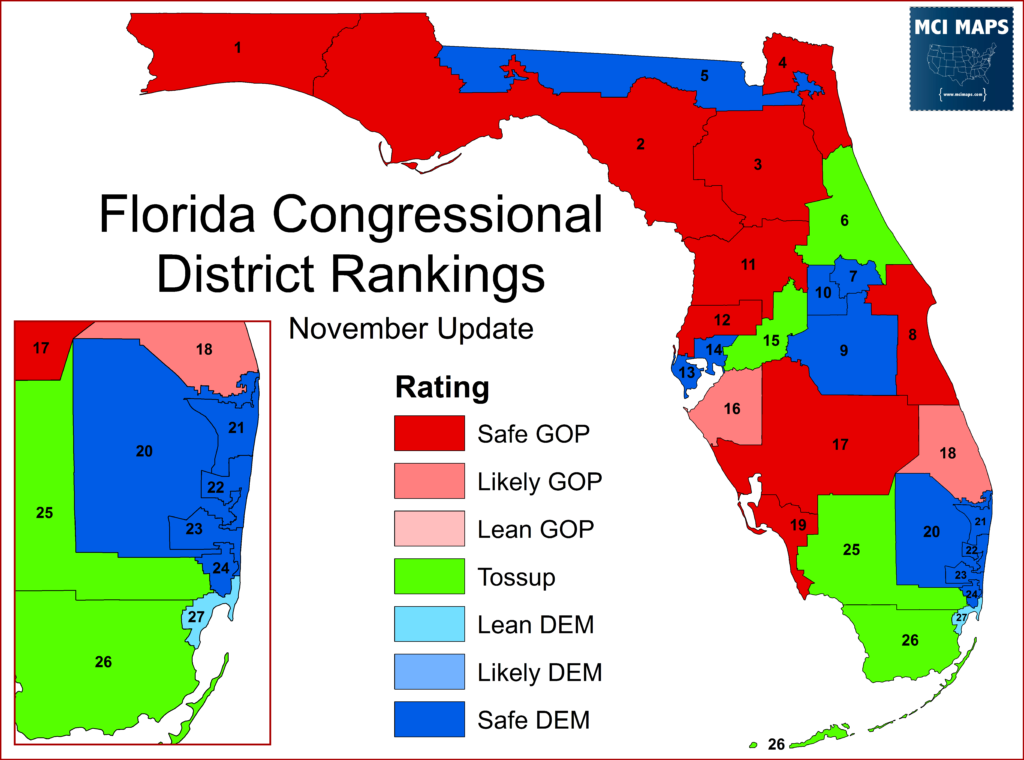
There are a few districts I want to highlight looking back on.
Florida 15th – GOP Defense
A fierce contest for FL-15 wound up falling to more traditional Republican leans. Polls had indicated a tight race and while the Democrat outperformed Nelson and Gillum, it wasn’t enough in a seat that went Republican by 7%. The biggest issue for Democrats was that the Hillsborough portion of the district did not wind up being as blue as was needed or hoped. This was a case where polls were a bit off on the final results. The GOP winner, Ross Spano, is not facing questions about undisclosed loans that he used on his campaign. The scandal could be an issue and make Spano vulnerable in two years. time will tell.
Florida 6th – GOP Defense
The contest for FL-06 was thought to be interesting – a district which backed Obama and narrowly Romney, but then swung hard to Trump – there was rumblings this working-class district might swing back. However, the FL-06 voted solid GOP and the Democratic candidates’ slight over-performance wasn’t enough. The district did swing back a bit from its 2016 margins, but it just was not as much as was needed.
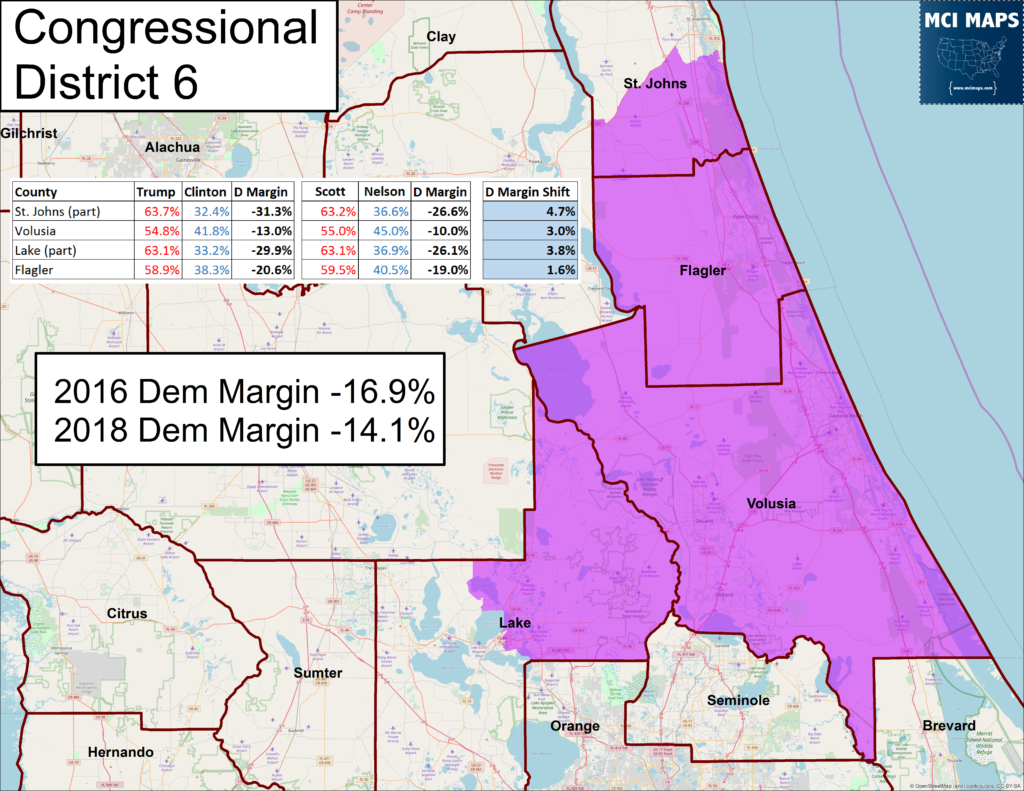
Using the Senate race compared to President, we see Democrats improving the most in the St Johns and Lake portions of the district. However, this is the exact wrong areas Democrats need to make the most improvements in. Volusia is over half the vote and needs to be the site of massive Democratic improvements. Obama’s win of Volusia in 2008 is what allowed him to win the district. However, with a growing retiree population in Volusia, coupled with working-class whites shifting further to the GOP, it is unlikely the trend toward Democrats will reach the levels its needed anytime in the near future.
Florida 25th – Republican Defense
The FL-25 race proved to be a fools gold for Democrats. The district’s swing toward Clinton in 2016 was not sustained as the district swung back to more traditional Cuban GOP roots. Not only did the district back statewide Republicans by 16%, it actually saw Congressman Diaz-Balart over-perform.
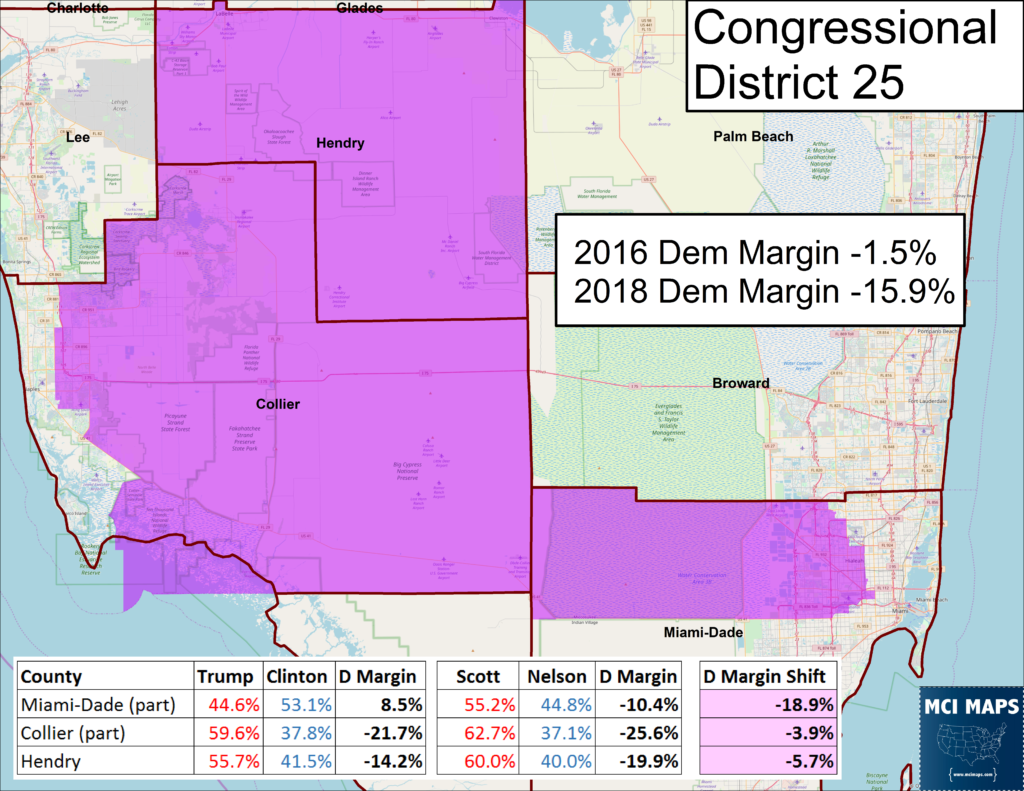
As discussed earlier in this article – this swing is likely due to a one-two punch of older cuban’s outpacing their younger counterparts, as well as these voters not equating all Republicans with Trump. Indeed the Miami-Dade portion of this district backed Republicans across the board, including for state legislature. The results look similar to the Rubio and Murphy breakdown for US Senate in 2016. This 16 point loss is still better than the 2014 governor breakdown. This district, which is is heavily dominated by the Miami-Dade portion, has some of the largest elasticity in the state and possibly nation.
Florida 18th – Republican Defense
The FL-18 race was always considered a long-shot for Democrats. Trump had won the seat by 9% and Brian Mast has built a semi-moderate image on guns that allowed him to preserve some Obama-Trump voters. Even as the district swung back to Democrats a bit, only backing Scott by 5%, it maintained a 9% win for Mast.
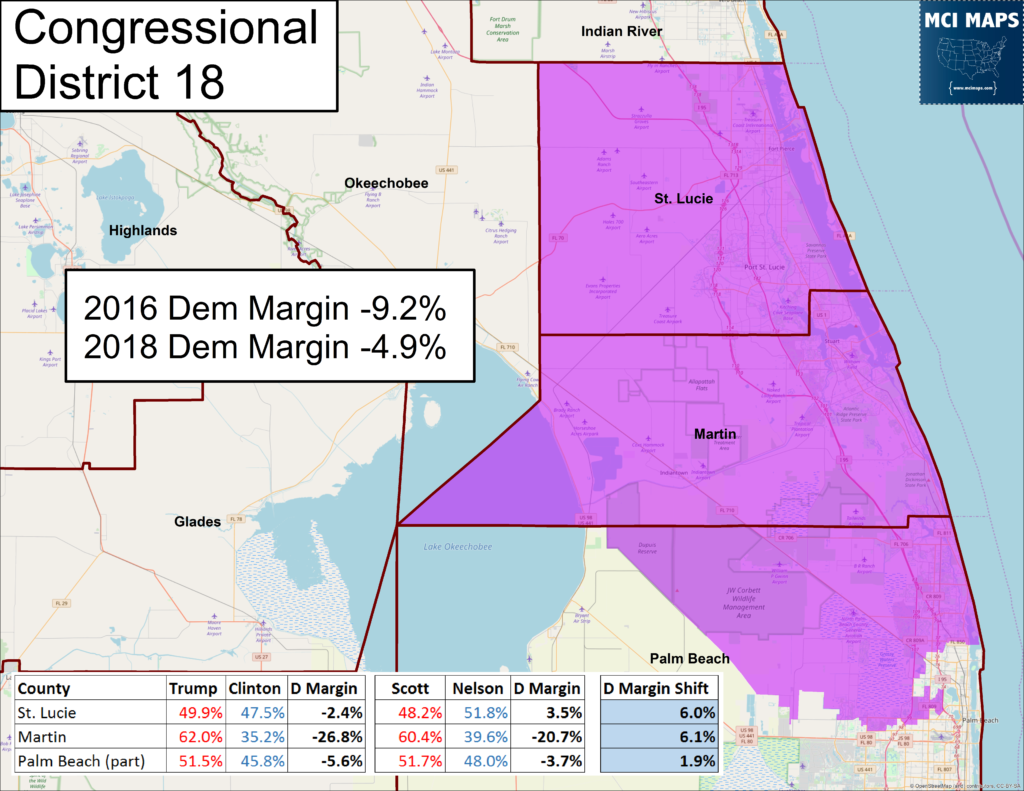
Despite the loss, the swing toward Democrats was an encouraging sign. St Lucie, a working-class county which backed Trump after being reliably blue for President since the 1990s, swung back to Nelson and Gillum. Martin, a more suburban county, also has a nice 6% swing toward Democrats. North Palm Beach, the most GOP portion of the county, remained much more static.
Florida 7th – Democratic Defense
One of the most notably Democratic defenses was in the 7th district, based out of Seminole County and part of Orange. Seminole is essentially the suburbs of Orlando and has gone from a Lean R county to much more swingish in the last few years. Gillum and Nelson actually won the county after Clinton came close in 2016. The Orange portion, which includes some suburbs, the University of Central Florida, and a notable Hispanic share, is solidly Democratic. The district was swingish, backing Obama narrowly over Romney but backing Scott over Crist in 2014’s Governor race. However, suburban rejection of Trump saw Clinton take the seat by a solid 7% and saw newcomer Stephanie Murphy narrowly topple longtime incumbent John Mica. It seemed like the re-election of Murphy would be a major fight in 2018 – but that did not come to pass.
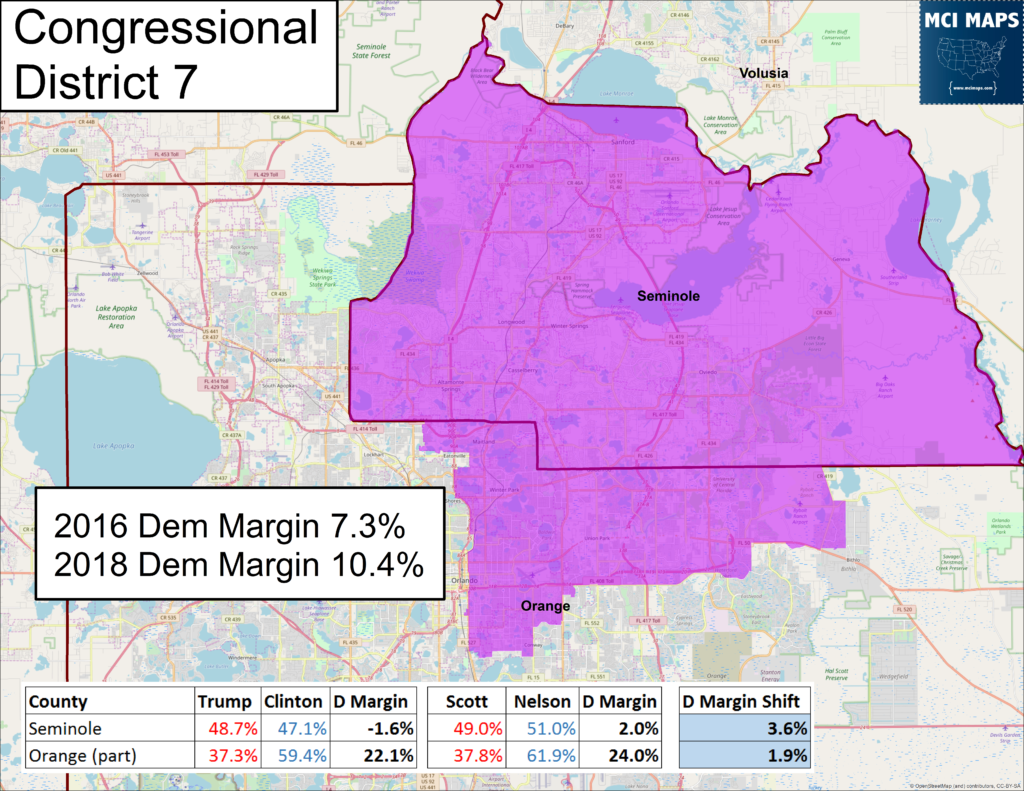
This go around, the district swung even more to the left – backing Nelson by over 10% and voting for all five statewide democratic candidates. It voted just around 10% to the left of the state, an unthinkable pattern just a few years ago. Seminole’s swing to the Democrats effectively prevented the GOP from having any chance here. The swing was felt downballot as well, as Democrats almost won an at-large commission district – falling just a few hundred votes short (the commission is entirely GOP and never features real general election fights). In the 7th, Seminole is supposed to be the GOP portion – but it is no longer acting as such. Murphy went on to easily defeat GOP State Rep Mike Miller, who gave up his state house seat to lose by 15 points.
Florida 13th – Democratic Defense
Charlie Crist, the former GOP Governor-turned Democratic Governor candidate in 2014, picked up the 13th district for Democrats in 2016. Redistricting forced a district based entirely in South Pinellas that included the South St Pete black vote (which for years had been added to a district across the Tampa Bay). This created a much more democratic district and allowed Crist to defeat Incumbent David Jolly (who had won a close special election under the old lines in 2014) by a few points. Jolly, a moderate and anti-Trump Republican, thought of challenging Crist again, but chose not to. This left Crist with no real opponents of note in 2018 and he easily won re-election by 15%. The district, which is made up of Democratic St Pete as well as more swingish areas like Clearwater (and includes both African-Americans, working-class whites, suburbs, and liberal white communities) went from only backing Clinton by 3 points to being more modestly Democratic – backing all statewide Democrats accept for Attorney General.
Comparing the Congressional Vote to the Statewide Races
As polarization continues to harden in our current politics, it should be no suprise to see the votes for congresspeople being closely linked with how the district voted for other races. With the latest results, how the statewide races broke down in a respective district match the party of congressperson for that district. Before 2018, the 27th and 26th had GOP Congresspeople but normally voted Democratic for races like US Senate and Governor. With both of those districts flipping, there are no crossover districts anymore.
The chart below compares the votes for the Congressional races to those for US Senate and Governor. The columns on the right show how the margins for Congress were different from Governor or Senator (positive means Democrat did better, negative means GOP did better).
Overall, incumbents did slightly better than their district’s vote for the Governor or Senate race. Notably exceptions are Matt Gaetz, and Debbie Wasserman-Schultz. Curbelo over-performed DeSantid and Scott in the 26th, but not enough to win, and the 27th also saw a notable over-performance from Salazar – but not enough to hold the seat. Meanwhile, Deutch, Soto, and Murphy also ran the must ahead of Gillum and Nelson.
Comparing the margin for Congress to the margin for US Senate shows a strong correlation.
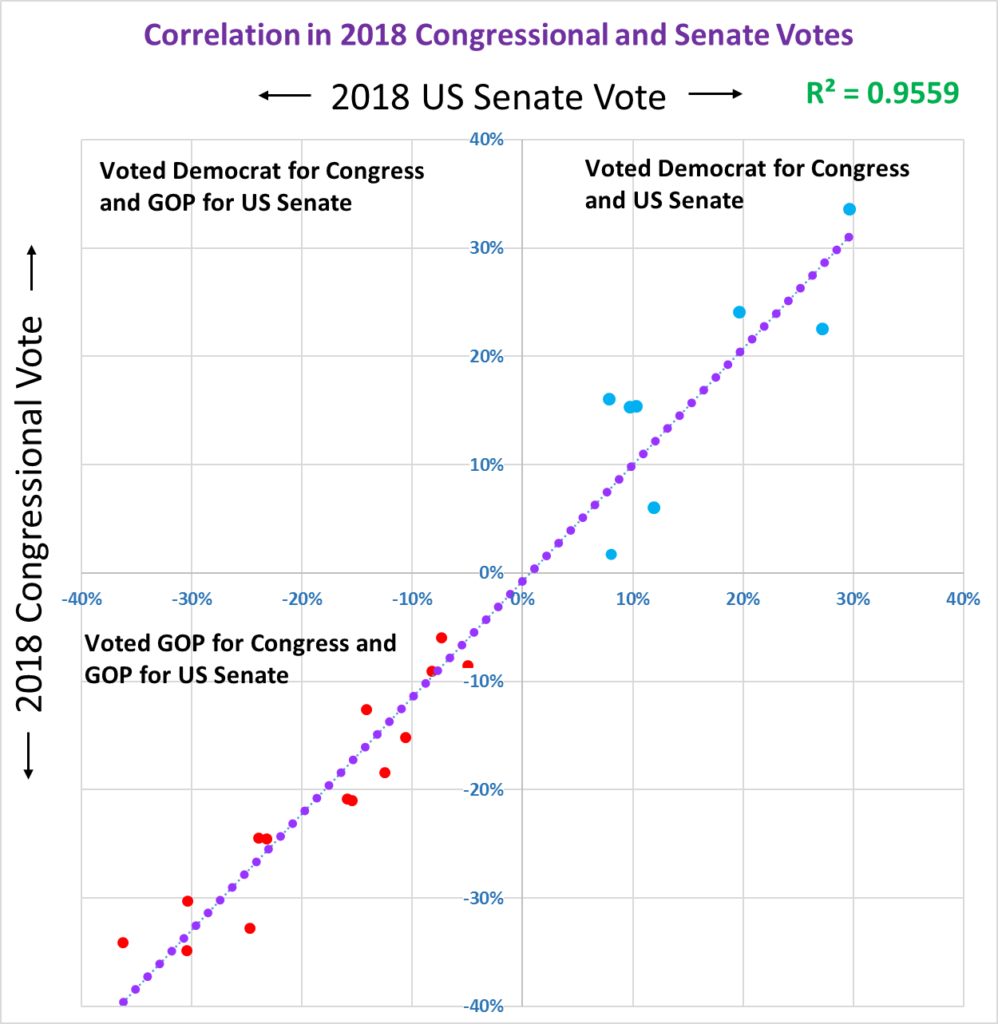
Looking Toward 2020
Baring scandal, it is likely another one of the fourteen GOP districts would need to move more to democrats overall to actually be in play for Democratic congressional candidate. The same can be said for the GOP, with Miami-Dade’s 27th and 26th being the exception.
On the GOP side, these districts are worth keeping an eye on.
- FL15 – Spano’s finance scandal could become an issue and may cause issues with his re-election or resignation if more comes to light. This scandal is developing.
- FL18 – Mast has proven to be a strong incumbent. This seat is likely only on the radar for Democrats if Mast doesn’t run again.
- FL25 – This district varies widely between midterms and Presidential cycles, partially driven by the age-gap in turnout among Cubans. Diaz-Balart seems to have retained strong appeal, over-performing Scott and Desantis. If the seat is open it might be more interesting but this district feels like its still out of Democratic hands.
On the DEM side
- FL26 – This district leans Democratic but is still far more GOP friendly down-ballot. I except many Republicans in the area are debating a run there. National environment will also likely play a role. The district should favor Democrats holding.
- FL27 – Donna Shalala clearly had some vulnerabilities but now that she is in the seat, she should be favored to hold the district. That said, worth seeing if any other notable Republicans from the county’s solid GOP bench opts for a run.
- FL07 – I imagine the GOP waits to Murphy makes a statewide run (maybe in 2022) before really aiming for this district. No reason to think she is vulnerable now.
Both parties now stand at a point where they have no obvious pickups and while they have some defenses to keep an eye on, nothing is especially vulnerable.
For the moment, Florida’s congressional delegation sits at a fairly decent partisan balance. We will see how things develop for 2020.

